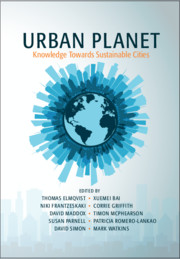Innate, intuitive, and experiential knowledge is a significant resource that we cannot afford to ignore. I am writing from Detroit, Michigan, in the United States – a city of invention and industry with a long history of valuing the new and pushing the boundaries of knowledge through innovation. Detroiters are constantly generating knowledge and striving for progress measured by new ideas. We are so busy moving forward that we rarely look back, overlooking valuable knowledge that we have left behind. In the face of every exciting advance in science and engineering and with respect to the daily terrestrial, celestial, and aquatic discoveries that enrich our understanding of the world around us, I offer the wisdom of the elders – the knowledge of those who have been here all along, which we know intuitively, innately, from living in a place or experiencing it. This knowledge is not less serious, less important, or less legitimate than the hard won, peer-reviewed, technical, and academic knowledge that is being generated in our laboratories, design studios, and academic institutions. Moreover, I propose that the traditional, historical, innate, and intuitive knowledge of all of the parts of this living ecosystem be mined, preserved, and used with the same gravitas and effect as the papers, studies, journal articles, and reports that we cite in support of our proposals, arguments, and opinions.
Mrs. Smith is a gardener with more than 60 years’ worth of hands-on experience growing flowers and vegetables in Detroit soil. She knows what plant varieties grow best here, when to plant each flower and vegetable that goes into her garden, and what soil amendments and practical pest-fighting remedies to apply to achieve the highest yields year after year. Mrs. Smith’s annual sunflower patch is a thing of beauty. I know this. I have benefitted from Mrs. Smith’s hyper-local and long-studied knowledge of her growing environment, and I have a desire to plant sunflowers as a part of a bio-remediation plan. Why should I rely upon a journal article generated by an academic in a far-off institution to tell me which sunflowers to grow, when I can look at the sunflowers that Mrs. Smith grows and ask her which varieties she’s had the most luck with over time in the very city where I wish to grow sunflowers? Why should Mrs. Smith’s experience-based knowledge be taken less seriously by my funder than the results published in that journal? They were.
Detroit is beginning an ambitious attempt at landscape-scale redesign of its landmass. Scores of design and planning professionals are being hired to lead this effort. Phrases like “internationally renowned designer” and “nationally recognized talent” are being used as a promise that Detroit will move ahead with new ideas generated by the leading designers of our time. A promise that in this area, like so many others, Detroit will break new ground, innovate, invent.
Let us pause from our headlong pursuit of the new and innovative for a moment to consider the value of the resource that is already embedded in that landscape which is to be redesigned. What grows in a place can tell you what the soil will support, and even where rivers once ran. Paths created by today’s travelers will tell you where sidewalks and streets would be most useful. People who are here now know what they need. Rather than assuming that the ideas and knowledge of talented outsiders are more relevant, useful, or reliable than the historical, innate, and intuitive knowledge of those who have been here all along, why not mine the knowledge and experience of Detroit’s elders to inform the redesign? Why not look at the landforms and the flora and fauna that once graced this landscape for instruction on what is most appropriate for the future? Shouldn’t the renowned designers that we are seeking, in fact, be expected to glean everything that they need to know from the plants, animals, and people who have experienced life in this place for so long?
Site-based, experiential knowledge is legitimate, valuable, and important. It can be found in the memories of our elders, in the patterns of nature, and in the traditions and history embedded within the culture of a place. There is much to be gained by a thoughtful and intentional attempt to capture, use, and respect this knowledge. We do ourselves, our research, and our future a disservice if we don’t stop and pay attention to the knowledge that we have left behind or that we have ignored entirely.

